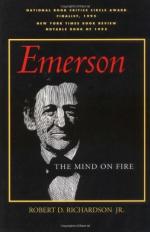
|
| Name: _________________________ | Period: ___________________ |
This test consists of 15 multiple choice questions and 5 short answer questions.
Multiple Choice Questions
1. What career paths was Emerson torn between?
(a) Law and teaching.
(b) Preaching and writing.
(c) Farming and writing.
(d) Preaching and law.
2. Where in his career was Emerson, in the scene Richardson describes in the Prologue?
(a) At its peak.
(b) At rock bottom.
(c) In its decline.
(d) At the beginning.
3. What troubled Emerson during his travels to the South?
(a) His engagement to Ellen Tucker.
(b) His religious faith.
(c) Slavery.
(d) His divinity studies.
4. Where does Richardson say Emerson and his brothers got their most profound education?
(a) Mary Moody Emerson.
(b) Their father.
(c) Ruth Haskins.
(d) Harvard.
5. Why was Emerson's meeting with Carlyle a "white day in his years"?
(a) He and Carlyle discovered that they were related.
(b) He and Carlyle challenged each other to define a new philosophy for the modern age.
(c) He and Carlyle became fast friends.
(d) He and Carlyle discovered a deep and productive antagonism.
6. What does Richardson say likely caused Emerson's eye problems?
(a) Overwork.
(b) Tuberculosis.
(c) Migraines.
(d) Stress.
7. How does Richardson characterize Emerson's feelings on returning to America?
(a) Impatient to begin new work.
(b) Anxious about finding his family well.
(c) Depressed about coming home.
(d) Despairing about finding a career.
8. What does Richardson say is the immovable anchor in Emerson's thought?
(a) That the mind is unique in history.
(b) That man can know God's mind.
(c) That individuality is divinity.
(d) That the mind is connected to everything.
9. In what religious sect was Edward Taylor active?
(a) Calvinist.
(b) Baptist.
(c) Unitarian.
(d) Shouting Methodist.
10. What practice did Emerson begin in college?
(a) Holding dinner parties for intellectuals.
(b) Keeping a journal.
(c) Sending money to his mother.
(d) Writing poetry.
11. How did Emerson describe his experience of Ellen's death?
(a) It was a turning point.
(b) It forced him to question his beliefs.
(c) It was a death for him as well.
(d) It was a second birth.
12. How does Richardson characterize Margaret Fuller's tone toward Emerson?
(a) Unctuous.
(b) Submissive.
(c) Self-aggrandizing.
(d) Persistent.
13. Who influenced Emerson during this turning point?
(a) Samson Reed.
(b) Edward Channing.
(c) Edward Everett.
(d) Mary Moody Emerson.
14. How does Richardson characterize Emerson's second wife?
(a) Reserved and self-critical.
(b) Wryly humorous and occasionally depressed.
(c) Devout and lyrical but sometimes full of doubts.
(d) Tender and passionate but sometimes anxious.
15. How did Emerson change after opening Ellen's casket?
(a) He became morbid in his writing.
(b) He decided to focus on the living.
(c) He began to believe in the life of the spirit.
(d) He began to see the importance of scientific study.
Short Answer Questions
1. What did Emerson suffer in 1837?
2. Who did NOT join Emerson where he was writing in 1834?
3. What was Emerson's first printed work?
4. How does Richardson characterize the development of Emerson's writing in 1834?
5. What did this turning point do for Emerson?
|
This section contains 522 words (approx. 2 pages at 300 words per page) |

|




